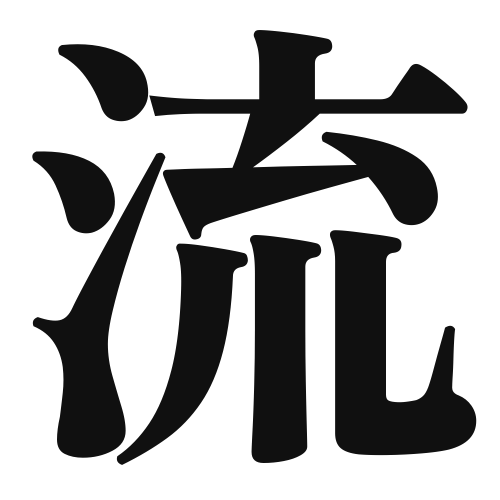1. Overview of Meaning
The kanji “流” (ryū) primarily means “flow” or “stream.” It conveys the idea of movement, whether it be water flowing in a river or the flow of time and ideas.
2. Formation and Radical
Formation of the Kanji: The kanji “流” is a phono-semantic compound (形声文字), which means it combines both a phonetic and a semantic component. The left part, “氵” (water radical), indicates its relation to water, while the right part, “流” (ryū), provides the pronunciation.
Radical: The radical of “流” is “氵” (water), which is commonly found in kanji related to water or liquid.
3. Examples of Usage
Common Words and Phrases: Some frequently used words that include “流” are:
- 流れ (ながれ, nagare) – flow
- 流行 (りゅうこう, ryūkō) – fashion or trend
- 流れる (ながれる, nagareru) – to flow
Example Sentences in Daily Conversation:
- 川の水が流れています。 (かわの みずが ながれています。) – The water in the river is flowing.
- 今の流行は何ですか? (いまの りゅうこうは なんですか?) – What is the current trend?
4. Synonyms and Antonyms
Similar Kanji: A similar kanji is “流派” (りゅうは, ryūha), which means “school” or “style,” particularly in arts or martial arts. The difference lies in the context of usage; “流” focuses on the concept of flow, while “流派” refers to a specific style or school.
Antonyms: An antonym of “流” could be “止” (とまる, tomaru), which means “to stop.” This represents the opposite of flow, indicating a halt in movement.
5. Cultural and Historical Background
Relation to Japanese Culture: The concept of “流” is deeply embedded in Japanese culture, often associated with nature and the passage of time. It reflects the Japanese appreciation for the fluidity and transience of life.
Proverbs and Idioms: One common proverb is “流れに逆らう” (ながれにさからう, nagare ni sakarau), which means “to go against the flow,” often used to describe someone who resists change or challenges the status quo.
